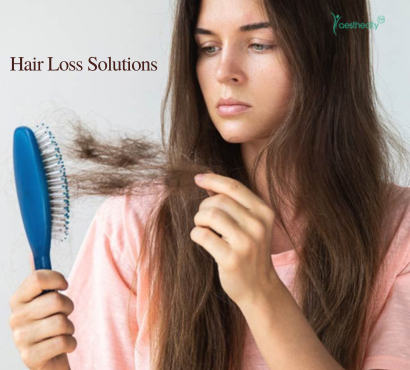Hair loss is a common concern affecting millions worldwide, leading to diminished self-esteem and confidence. In India, factors like genetics, lifestyle, and environmental conditions contribute to hair thinning and baldness. Fortunately, advancements in medical science offer various solutions, ranging from topical medications to innovative therapies like Platelet-Rich Plasma (PRP). This comprehensive guide delves into these treatments, providing insights into their mechanisms, effectiveness, and considerations for those seeking hair restoration.
Understanding Hair Loss
Hair loss, or alopecia, can result from various factors:
- Genetics: Androgenetic alopecia, commonly known as male or female pattern baldness, is hereditary.
- Hormonal Changes: Conditions like thyroid imbalances or hormonal fluctuations can lead to hair thinning.
- Medical Conditions: Scalp infections or diseases like alopecia areata.
- Medications: Drugs used for cancer, arthritis, depression, and heart problems may have hair loss as a side effect.
- Stress and Lifestyle: High stress levels, poor diet, and inadequate hair care routines.
Recognizing the underlying cause is crucial for selecting the appropriate treatment.
Medications for Hair Loss
1. Minoxidil
What is Minoxidil? Minoxidil is a topical solution applied directly to the scalp to stimulate hair growth. It’s available over-the-counter in 2% and 5% concentrations.
How Does It Work? Minoxidil prolongs the anagen phase (growth phase) of hair follicles and increases blood flow to the scalp, promoting hair regrowth.
Effectiveness: Regular application can result in noticeable hair regrowth within 3 to 6 months. Consistency is key, and discontinuation may lead to a reversal of results.
Considerations:
- Possible side effects include scalp irritation and unwanted facial hair growth.
- Should be used under medical supervision, especially for individuals with cardiovascular conditions.
2. Finasteride
What is Finasteride? Finasteride is an oral prescription medication that inhibits the enzyme 5-alpha-reductase, responsible for converting testosterone to dihydrotestosterone (DHT). Elevated DHT levels are linked to hair loss.
How Does It Work? By reducing DHT levels, Finasteride slows hair loss and, in some cases, promotes regrowth in areas affected by androgenetic alopecia.
Effectiveness: Studies indicate that Finasteride can reduce hair loss progression and stimulate new growth in many users. Results typically become evident after several months of consistent use.
Considerations:
- Potential side effects include sexual dysfunction and mood changes.
- Not recommended for use by women, particularly those who are pregnant or may become pregnant, due to the risk of birth defects.
- Requires a doctor’s prescription and regular monitoring.
Combination Therapy: Minoxidil and Finasteride
Combining topical Minoxidil with oral Finasteride has shown enhanced effectiveness in treating hair loss compared to using either treatment alone. This approach addresses hair loss through multiple mechanisms, offering a synergistic effect.
Considerations:
- Increased risk of side effects from both medications.
- Should only be pursued under the guidance of a healthcare professional.
Platelet-Rich Plasma (PRP) Therapy
What is PRP Therapy?
PRP therapy involves drawing a small amount of the patient’s blood, processing it to concentrate the platelets, and injecting it into the scalp. Platelets are rich in growth factors that can stimulate hair follicles and promote hair growth.
How Does It Work?
The growth factors in PRP help to:
- Stimulate dormant hair follicles.
- Increase blood supply to the hair follicles.
- Enhance the thickness of the hair shaft.
Effectiveness:
Studies have shown that PRP therapy can be effective in increasing hair density and reducing hair loss, particularly in individuals with androgenetic alopecia. Multiple sessions are typically required to achieve optimal results.
Considerations:
- Cost: In India, each PRP session can range from ₹5,500 to ₹15,000, depending on the clinic and location. Multiple sessions are often necessary. citeturn0search1
- Safety: PRP is generally considered safe since it uses the patient’s own blood, minimizing the risk of allergic reactions. However, mild side effects like scalp tenderness and swelling can occur.
- Suitability: Not everyone is an ideal candidate. Individuals with certain medical conditions or those on specific medications may not be suitable for PRP therapy.
Comparing Treatments
| Treatment | Method | Effectiveness | Cost in India | Considerations |
| Minoxidil | Topical application | Promotes hair regrowth in many users | ₹700 – ₹1,500 per month | Requires ongoing use; possible scalp irritation |
| Finasteride | Oral medication | Slows hair loss; potential regrowth | ₹200 – ₹500 per month | Prescription needed; potential sexual side effects |
| PRP Therapy | Scalp injections | Increases hair density; reduces hair loss | ₹5,500 – ₹15,000 per session | Multiple sessions required; costlier; mild side effects like scalp tenderness |
Lifestyle and Home Remedies
In addition to medical treatments, certain lifestyle changes can support hair health:
- Balanced Diet: Ensure adequate intake of vitamins and minerals like iron, zinc, and vitamin D.
- Stress Management: Practices like yoga and meditation can reduce stress-related hair loss.
- Proper Hair Care: Avoid excessive heat styling, harsh chemicals, and tight hairstyles that can damage hair.
When to Consult a Doctor
It’s advisable to seek medical advice if:
- You experience sudden or patchy hair loss.
- You notice more hair loss than usual when combing or washing your hair.
- Hair loss is accompanied by itching, pain, or scalp redness.
A dermatologist can help determine the underlying cause and recommend appropriate treatment.
FAQs
Q1: Can women use Minoxidil and Finasteride for hair loss?
A: Minoxidil is approved for use in women and can be effective in treating female pattern hair loss. Finasteride, however, is not recommended for women, especially those who are pregnant or may become pregnant, due to the risk of birth defects.
Q2: How long does it take to see results from PRP therapy?
A: Patients may start noticing improvements after 3 to 4 sessions, with optimal results typically observed after 6 to 8 sessions. Maintenance treatments may be required to sustain results.
Q3: Are there any natural remedies effective for hair loss?
A: While natural remedies like herbal supplements and essential oils may support overall hair

